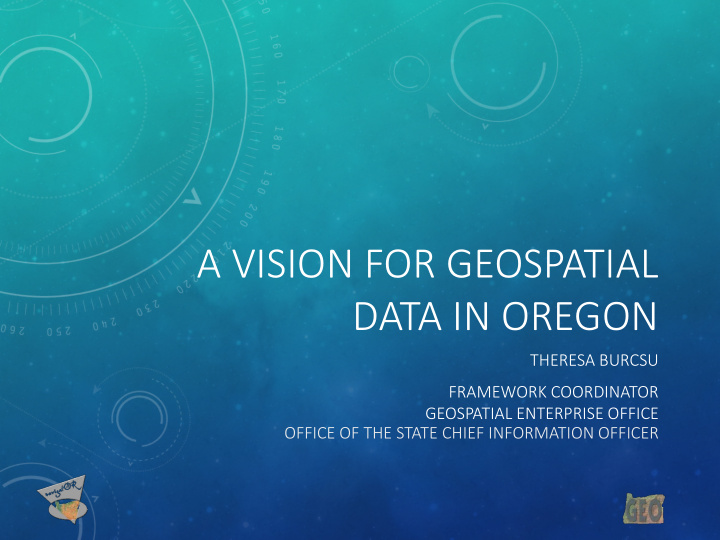



A VISION FOR GEOSPATIAL DATA IN OREGON THERESA BURCSU FRAMEWORK COORDINATOR GEOSPATIAL ENTERPRISE OFFICE OFFICE OF THE STATE CHIEF INFORMATION OFFICER
OVERVIEW • Data in organizations • Oregon’s spatial data infrastructure • Power Lines Work Group
DATA IN ORGANIZATIONS • What is the role of data in your organization? • Drives, informs, illuminates, enables service provision
A VISION FOR GEOSPATIAL DATA IN OREGON Authoritative GIS data is available and accessible when needed.
navigat OR • Oregon’s spatial data infrastructure Technology & Data procedures • Shared approach to geospatial Institutional information and relationships & business technology practices
SHARED APPROACH: The One Government Approach • Connect business processes across silos • Ensure reliable, consistent, and permanent connections • How? • Geospatial data sharing, ORS 276A • Governance • Coordination
DATA IN NAVIGATOR: FRAMEWORK DATA Nationally recognized Oregon-specific Land Cove ver/Use Use Cadas astral al Bioscie ience Transportatio ion Climat ate Hydro rogra raphy Utilit litie ies Admin in. B Boundarie ies Prepared ednes ess Elevat ation Geoscie Ge ience Image gery Hazard rds Geodetic Ge ic C Control Address P Points Coastal/ l/Marin ine
navigat OR GOALS & OBJECTIVES • Develop and maintain technical and organizational structures to support: • Full statewide maturation of Oregon’s geospatial Framework data • Data sharing and secure access for a broad user community • Provide efficient environment and tools to support Framework data elements throughout data lifecycle
SHARED INFORMATION VISION • Data developed to collaboratively designed standards • One or more organizations steward each base data set, on behalf of all others, in a coordinated way
MANAGING A SHARED RESOURCE • Keys to success • Consistent communications • Established policies, regulations, and procedures • Rules and standards for data maintenance and refresh
HOW? High GIS capacity Interface Low GIS capacity
MANAGING A SHARED RESOURCE • Governance: • Shared organizational structure with equal representation from all sectors • Legislative authority to establish shared structure (ORS 166)
TAKE HOME MESSAGE • Data sharing is the most critical element for consistent service provision • Consistent service provision best provided through a shared approach • A shared approach depends on excellent governance
POWER LINES WORK GROUP JAN. 2017 – JULY 2017 • Documented data security and public access norms and rules • Documented electric power line data use cases • Provided guidance to BLM in its development of a publicly shareable data set • Identified need to engage larger community
THANK YOU! For more information go to GIS.OREGON.GOV
SELECTED ENERGY-RELATED DATA ELEMENTS Geodetic Utilities Administrative Other Control Boundaries Control points Powerlines County boundaries Public buildings Electric distribution School districts Habitat distributions facilities City limits Land ownership Electric generation & Geothermal heating Tax lots transmission facilities districts Solar radiation Oil & gas supply and Wilderness areas Earthquake hazard transmission facilities Monthly wind flow
SELECTED EMERGENCY RESPONSE DATA ELEMENTS Imagery and Utilities Preparedness and Others Elevation Hazards Orthoimagery Powerlines Address points Bridges Digital elevation Electric distribution Correctional facilities Road centerlines models facilities Emergency facilities Tax lots Bathymetry Electric generation & Health care facilities Shoreline and Slope transmission shorezone Public buildings facilities Geodetic control Schools and day care Oil & gas supply and Geomorphology transmission Flood zones facilities Soils Earthquake hazard Landslide zone
HOW DO YOU JOIN? 1. Visit gis.oregon.gov 2. Attend a Framework Forum 3. Join GEO’s email lists 4. Contact FIT leads 5. Contact Theresa Burcsu, Framework Coordinator Theresa.Burcsu@Oregon.gov 503-378-3157
Recommend
More recommend